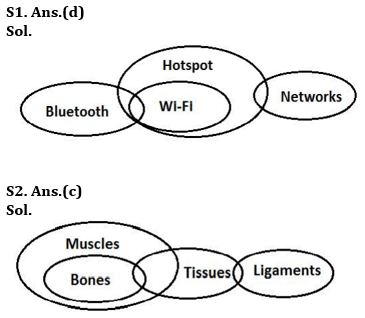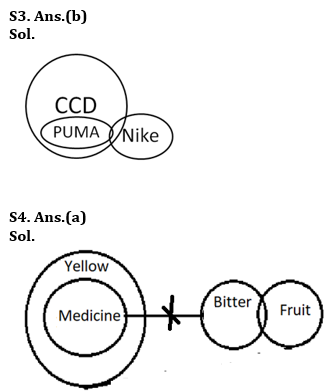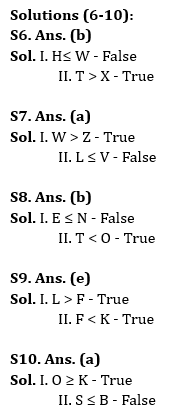Directions (1-5): In the question below, some statements are given followed by two conclusions numbered I and II. You have to take the given statements to be true even if they seem to be at variance with commonly known facts. Read all the conclusions and then decide which of the given conclusions logically follows from the given statements disregarding commonly known facts.
Q1. Statements: Only a few Bluetooth are Wi-Fi.
All Wi-Fi are Hotspot.
Only a few Hotspots are Networks.
Conclusions: I. Some Wi-Fi are Networks.
II. All Hotspot are Bluetooth.
(a) Only I follows
(b) Only II follows
(c) Either I or II follows
(d) Neither I nor II follows
(e) Both I and II follow
Q2. Statements: All Bones are Muscles.
Only a few Bones are Tissues.
Only a few Tissues are Ligaments.
Conclusions: I. Some Muscles are Ligaments.
II. No Ligaments are Muscles.
(a) Only I follows
(b) Only II follows
(c) Either I or II follows
(d) Neither I nor II follows
(e) Both I and II follow
Q3. Statements: Only a few Nike are PUMA.
All PUMA are CCD.
Conclusions: I. All Nike are PUMA.
II. Some CCD are Nike.
(a) Only I follows
(b) Only II follows
(c) Either I or II follows
(d) Neither I nor II follows
(e) Both I and II follow
Q4. Statements: Some fruit is bitter.
No bitter is medicine.
All medicine is Yellow.
Conclusions: I. All bitter can be Yellow.
II. No fruits is medicine.
(a) Only I follows
(b) Only II follows
(c) Either I or II follows
(d) Neither I nor II follows
(e) Both I and II follow
Q5. Statements: Some shows are plays.
Some plays are movies.
No movie is theatre.
Conclusions: I. All movies are plays.
II. Some shows are definitely not theatres.
(a) Only I follows
(b) Only II follows
(c) Either I or II follows
(d) Neither I nor II follows
(e) Both I and II follow
Directions (6-10): In the following questions assuming the given statement to be true, find which of the conclusion(s) among given conclusions is/are definitely true and then give your answers accordingly.
Q6. Statements: T > W > U; X < U > M > K; H < K
Conclusions: I. H ≤ W II. T > X
(a) Only I is true
(b) Only II is true
(c) Either I or II is true
(d) Neither I nor II is true
(e) Both I and II are true
Q7. Statements: V > W ≥ I > Q; L = F < Y < Q; L > Z
Conclusions: I. W > Z II. L ≤ V
(a) Only I is true
(b) Only II is true
(c) Either I or II is true
(d) Neither I nor II is true
(e) Both I and II are true
Q8. Statements: E ≤ T ≤ H = J, N= O > C ≥ R, J < N
Conclusions: I. E ≤ N II. T < O
(a) Only I is true
(b) Only II is true
(c) Either I or II is true
(d) Neither I nor II is true
(e) Both I and II are true
Q9. Statements: I = N < K, T > F ≤ I, L = H ≥ T
Conclusions: I. L > F II. F < K
(a) Only I is true
(b) Only II is true
(c) Either I or II is true
(d) Neither I nor II is true
(e) Both I and II are true
Q10. Statements: B = K > E, R = D < O ≥ B, G > S ≥ R
Conclusions: I. O ≥ K II. S ≤ B
(a) Only I is true
(b) Only II is true
(c) Either I or II is true
(d) Neither I nor II is true
(e) Both I and II are true
Solutions









 GA Capsule for SBI Clerk Mains 2025, Dow...
GA Capsule for SBI Clerk Mains 2025, Dow...
 The Hindu Review October 2022: Download ...
The Hindu Review October 2022: Download ...
 ECGC PO Scorecard 2025 Out, Check Marks
ECGC PO Scorecard 2025 Out, Check Marks




